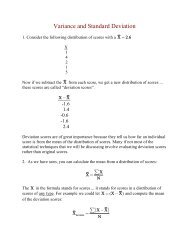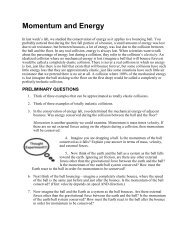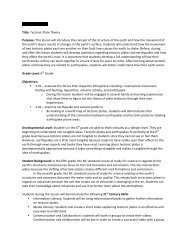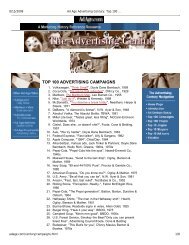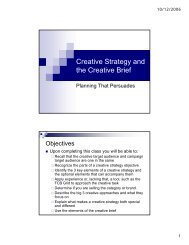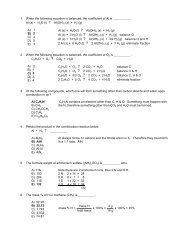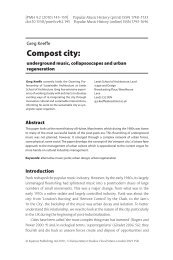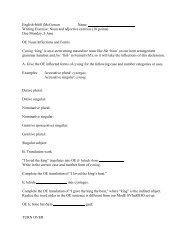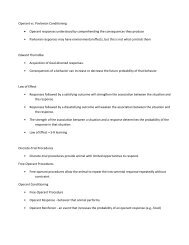Schedules of Reinforcement Continuous Reinforcement (CRF ...
Schedules of Reinforcement Continuous Reinforcement (CRF ...
Schedules of Reinforcement Continuous Reinforcement (CRF ...
Create successful ePaper yourself
Turn your PDF publications into a flip-book with our unique Google optimized e-Paper software.
<strong>Schedules</strong> <strong>of</strong> <strong>Reinforcement</strong><br />
• <strong>Continuous</strong> <strong>Reinforcement</strong> (<strong>CRF</strong>) - Every response is followed by reinforcement<br />
• Partial <strong>Reinforcement</strong> - Not every response is followed by reinforcement<br />
Partial-<strong>Reinforcement</strong> <strong>Schedules</strong><br />
• Fixed Ratio (FR) - <strong>Reinforcement</strong> provided after a fixed number <strong>of</strong> responses<br />
Patterns <strong>of</strong> Responding on FR <strong>Schedules</strong><br />
• Post-reinforcement Pause - pause in responding immediately after reinforcement<br />
• May be an analogue <strong>of</strong> procrastination<br />
• Duration <strong>of</strong> pause related to size <strong>of</strong> FR schedule<br />
• Ratio Run - high rate <strong>of</strong> responding following pause<br />
• Ratio Strain - decrease in responding when ratio requirement is too high<br />
Variable-Ratio Schedule<br />
• Variable Ratio - a variable number <strong>of</strong> responses are required to obtain reinforcement<br />
• Responding is relatively consistent and high<br />
• Post-reinforcement pause tends to be shorter<br />
Practice Quiz<br />
1. On a _____ schedule <strong>of</strong> reinforcement each response is reinforced, whereas on<br />
a ______ schedule <strong>of</strong> reinforcement, only some responses are reinforced.<br />
2. Every time you flick the light switch, the lights come on. This is an example <strong>of</strong><br />
______.<br />
3. A schedule on which 15 responses are required for each reinforcer is<br />
abbreviated ______.<br />
4. An FR 1 schedule <strong>of</strong> reinforcement can also be called a ______ schedule.<br />
5. An FR 200 schedule will result in a (longer/shorter) ______ pause than an FR 50<br />
schedule.<br />
6. About one in ten people approached by a panhandler actually gives him money.<br />
His behavior <strong>of</strong> panhandling is on a ______ schedule <strong>of</strong> reinforcement.<br />
7. Graduate students <strong>of</strong>ten have to complete an enormous amount <strong>of</strong> work in the<br />
initial year <strong>of</strong> their program. For some students, the workload involved is far<br />
beyond anything they have previously encountered. As a result, their study<br />
behavior may become increasingly disorganized throughout the year, a process<br />
known as ______ _______.<br />
8. A variable ratio schedule typically produces a (high/low) _____ rate <strong>of</strong> behavior<br />
(with/without) ______ a post-reinforcement pause.<br />
Interval <strong>Schedules</strong><br />
• Reinforced for first response following a certain period <strong>of</strong> time<br />
• Fixed Interval (FI) - reinforcement provided for the first response following a fixed<br />
period <strong>of</strong> time<br />
Fixed-Interval Schedule<br />
• Characteristics <strong>of</strong> Responding:
• FI scallop - long pause in responding following reinforcement, followed by<br />
accelerating rate<br />
• Greatest responding just prior to end <strong>of</strong> interval<br />
• Animal learns temporal interval<br />
• Might be similar to inhibition <strong>of</strong> delay<br />
Variable-Interval Schedule<br />
• Variable Interval (VI) - first response following a variable interval <strong>of</strong> time is reinforced<br />
• Tends to produce a low to moderate, steady rate <strong>of</strong> responding<br />
Comparison <strong>of</strong> Response Rates<br />
Practice Quiz<br />
1. In general, variable interval schedules produce a (low to moderate/high) ______<br />
rate <strong>of</strong> response. This rate tends to be (steady/fluctuating) ______.<br />
2. Responding on an FI schedule is <strong>of</strong>ten characterized by a ______ pattern <strong>of</strong><br />
responding.<br />
3. On a pure FI schedule, any response that occurs (during/following) _____ the<br />
interval is irrelevant.<br />
4. On which type <strong>of</strong> schedule does the rate <strong>of</strong> responding have the greatest effect<br />
on how <strong>of</strong>ten the animal is reinforced?<br />
Other <strong>Schedules</strong> <strong>of</strong> <strong>Reinforcement</strong><br />
• Differential <strong>Reinforcement</strong> <strong>of</strong> High Rates (DRH) - high response rates are reinforced<br />
• Differential <strong>Reinforcement</strong> <strong>of</strong> Low Rates (DRL) - low response rates are reinforced<br />
• Differential <strong>Reinforcement</strong> <strong>of</strong> Other Behavior (DRO) - reinforced for performing any<br />
behavior other than the specified behavior
Extinction<br />
• Side effects<br />
• Extinction burst – temporary increase in the frequency and intensity <strong>of</strong> responding<br />
• Increase in Variability<br />
• Emotional Behavior<br />
• Aggression<br />
• Resurgence – reappearance during extinction <strong>of</strong> other behaviors that had once<br />
been effective in obtaining reinforcement<br />
• Depression<br />
What’s learned during extinction?<br />
• Why does the animal stop responding?<br />
•<br />
S D : RS R<br />
• S: RO (stimulus: response outcome)<br />
• Which does the animal learn?<br />
• Weakening <strong>of</strong> the R-O association?<br />
• Inhibitory S-O association?<br />
• Inhibitory R-O association?<br />
• Inhibitory S-R association?<br />
Rescorla (1993)<br />
Discrimination Train Extinguish Test<br />
N: Rc-P<br />
L: Rc-P<br />
R1-P<br />
R2-P<br />
L:R1-noP and<br />
N:R2-noP<br />
N: R1,<br />
N: R2,<br />
L: R1,<br />
L: R2<br />
• N = noise; L = Light; P = food pellet<br />
• R1 = response lever; R2 = Chain Pull<br />
Rescorla (1993)<br />
• Prediction for weakened R-O association?<br />
• Prediction for inhibitory S-O association?<br />
• Prediction for inhibitory R-O association?<br />
• Prediction for inhibitory S-R association?<br />
Results
Partial <strong>Reinforcement</strong> Extinction Effect<br />
• Responding continues longer following partial reinforcement than following<br />
continuous reinforcement<br />
• Explanations:<br />
• Discrimination Hypothesis - transition from partial reinforcement to extinction is<br />
less noticeable<br />
Other explanations <strong>of</strong> the PREE<br />
• Frustration Theory (Amsel)<br />
• Initial training:<br />
• <strong>Continuous</strong> <strong>Reinforcement</strong><br />
• Every response is reinforced<br />
• Partial <strong>Reinforcement</strong><br />
• Not every response is reinforced<br />
• Nonreinforcement produces frustration<br />
• Continuing to respond in the presence <strong>of</strong> frustration is eventually reinforced<br />
• Frustration acts as a discriminative stimulus<br />
Frustration Theory<br />
• Why do animals show the partial reinforcement extinction effect?<br />
• During extinction animals experience frustration<br />
• Animals that never previously experienced frustration (<strong>CRF</strong>) quit sooner than<br />
animals that have been reinforced while experiencing frustration (Partial<br />
reinforcement)



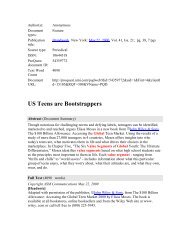

![Graduate Bulletin [PDF] - MFC home page - Appalachian State ...](https://img.yumpu.com/50706615/1/190x245/graduate-bulletin-pdf-mfc-home-page-appalachian-state-.jpg?quality=85)
